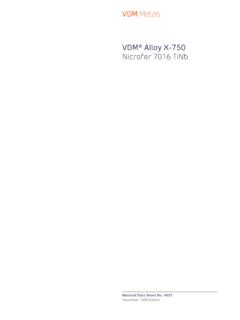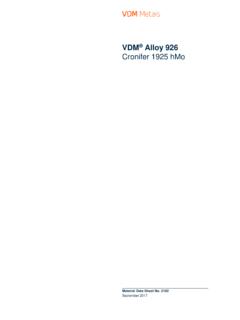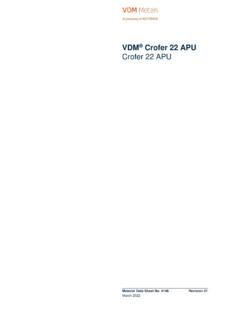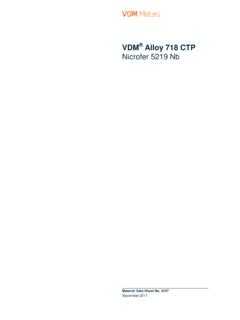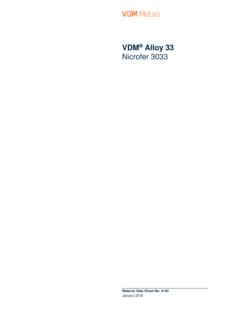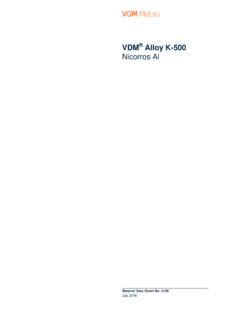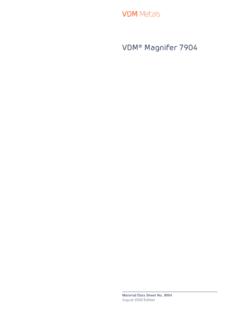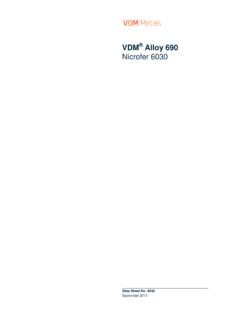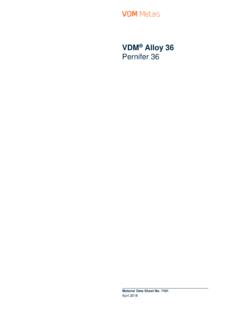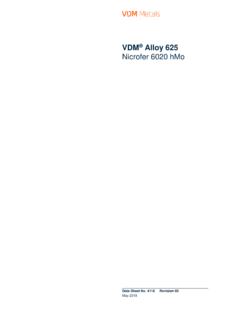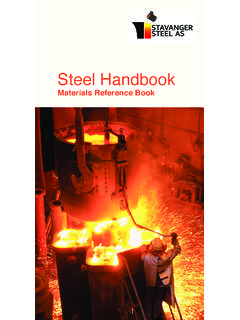Transcription of VDM Alloy 751 Nicrofer 7016 TiAl
1 VDM Alloy 751 Nicrofer 7016 TiAl Material Data Sheet No. 4047 November 2017 November 2017 VDM Alloy 751 2 VDM Alloy 751 is an age-hardenable nickel-chromium-iron Alloy . The hardenability is obtained by means of addition of titanium, niobium and aluminum that form strengthening precipitates during heat treatment. It can be delivered in a solu-tion-annealed or hardened condition. It is generally used in the age-hardened condition. VDM Alloy 751 is characterized by: High tensile strength up to 600 C (1,110 F) High creep and fatigue strength up to 820 C (1,510 F) High oxidation resistance up to 980 C (1,795 F) Excellent mechanical properties in low temperature environments Good corrosion resistance in high and low temperatures and high resistance against stress corrosion Good weldability (resistance and fusion welding)
2 Designations and Standards Standard Material designation EN NiCr16Fe7 TiAl UNS N07751 Table 1 Designations and standards VDM Alloy 751 Nicrofer 7016 TiAl November 2017 VDM Alloy 751 3 Chemical Composition Ni Cr C S Mn Si Ti Nb Cu Fe Al Min. 70 14 2 5 Max. 17 1 9 Due to technical reasons the Alloy may contain additional elements Table 2 Chemical composition (%) Physical properties Density Melting range Relative magnetic permeability at 20 C (68 F) Curie Temperatur g/ cm bei 20 C 512 lb/ft at 68 F 1,390 1,430 C 2,530 2,610 F -223 C (-369 F)
3 Temperature Specific heat capacity Thermal conductivity Electrical resistivity Modulus of elasticity Coefficient of thermal expansion C F Jkg K Btulb F Wm K Btu insq ft h F cm GPa 103 ksi 10-6K 10-6 F 20 68 431 123 213 100 212 460 125 200 392 480 127 189 300 572 500 104. 128 400 752 520 114 130 194 500 932 535 125 131 600 1,112 560 137 130 180 700 1,292 600 149 129 172 800 1,472 660 162 129 161 900 1,652 750 175 127 144 1,000 1,832 189 126 Table 3 Typical physical properties (at room and elevated temperatures) November 2017 VDM Alloy 751 4 Microstructural properties VDM Alloy 751 has a cubic, face-centered crystal structure.
4 The excellent mechanical strength is due to the precipitation hardening in the gamma phase ( ) by formation of the gamma prime phase ( ) along with some carbides during the hardening heat treatment. Mechanical properties The following mechanical properties apply to VDM Alloy 751 in the solution-annealed and quenched condition. Temperature Yield strength Rp 0,2 Tensile strength Rm Elongation at fracture A C F MPa ksi MPa ksi % 20 68 716 104 1080 156 24 200 212 670 1020 148 27 400 392 652 983 143 30 600 572 660 912 132 25 700 752 660 861 125 14 800 534 637 12 900 271 35 29 Table 4a Typical mechanical properties of solution-annealed and precipitation hardened VDM Alloy 751 at room and elevated temperatures Temperature Yield strength Rp 0.
5 2 Tensile strength Rm Elongation at fracture A C F MPa ksi MPa ksi % 20 68 391 782 113 42 200 212 380 700 102 44 400 392 371 640 47 600 572 360 600 87 47 700 752 350 593 86 17 800 340 577 7 900 243 316 34 1,000 73 78 Table 4b Typical mechanical properties of solution-annealed VDM Alloy 751 at room and elevated temperatures November 2017 VDM Alloy 751 5 Corrosion resistance VDM Alloy 751 demonstrates an excellent corrosion resistance in high and low temperatures and the Alloy furthermore has a high resistance against stress corrosion.
6 The resistance against oxidizing conditions is remarkably high at up to 980 C (1,800 F). Applications Due to its high strength up to 820 C (1,508 F) and its excellent corrosion resistance, VDM Alloy 751 can be used in a wide range of applications. A typical application is exhaust valves of combustion engines. November 2017 VDM Alloy 751 6 Fabrication and heat treatment VDM Alloy 751 can be easily deformed both hot and cold and can also be machined. However, for all processing, ma-chines are required that take the mechanical properties like the high strength and characteristic work hardening rates into account.
7 The deformation should preferably take place in the solution-annealed condition. Heating It is important that the workpieces are clean and free of any contaminations before and during heat treatment. Sulfur, phosphorus, lead and other low-melting point metals can result in material damage during the heat treatment. This type of contamination is also contained in marking and temperature-indicating paints or pens, and also in lubricating grease, oils, fuels and similar materials. The sulfur content of fuels must be as low as possible.
8 Natural gas should contain less than of sulfur. Heating oil with a maximum sulfur content of is also suitable. Electric furnaces are preferable for their precise temperature control and a lack of contaminations from fuels. The furnace temperature should be set between neutral and slightly oxidizing and it should not change between oxidizing and reducing. The workpieces must not come into direct contact with flames. Hot forming VDM Alloy 751 can be optimally hot formed in a temperature range between 1,200 and 980 C (2,190 and 1,800 F) with subsequent rapid cooling down.
9 For heating up, the workpieces are placed in the furnace that is heated up to the hot forming temperature. Once the temperature has equalized, a retention time of at least 60 minutes for each 100 mm of workpiece thickness should be observed. After this, the workpieces are removed immediately and deformed within the specified temperature window. When falling below a temperature of 980 C (1,800 F), the workpiece should be heated up as described above, as it would be too firm for further hot forming otherwise.
10 Heat treatment after hot forming is recommended for the optimization of mechanical properties and corrosion resistance. To ensure good mechanical prop-erties, the last deforming step should be at least 20% and not exceed a temperature of 1,100 C (2,012 F). Cold forming VDM Alloy 751 is cold formed ideally in the solution-annealed state. The material has a significantly higher work harden-ing rate than austenitic stainless steels. This must be taken into account for the design and selection of forming tools and equipment, and for the planning of forming processes.
